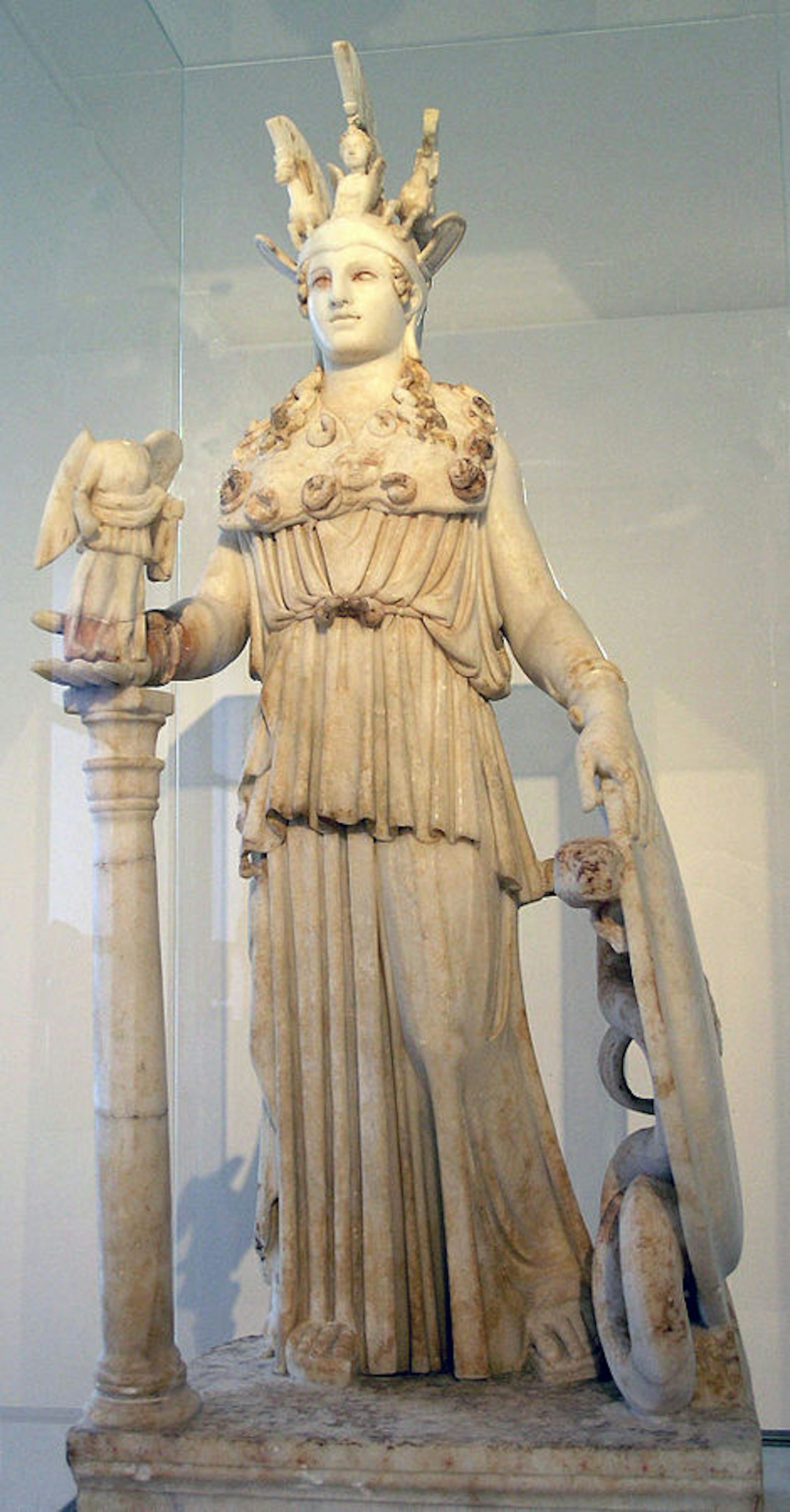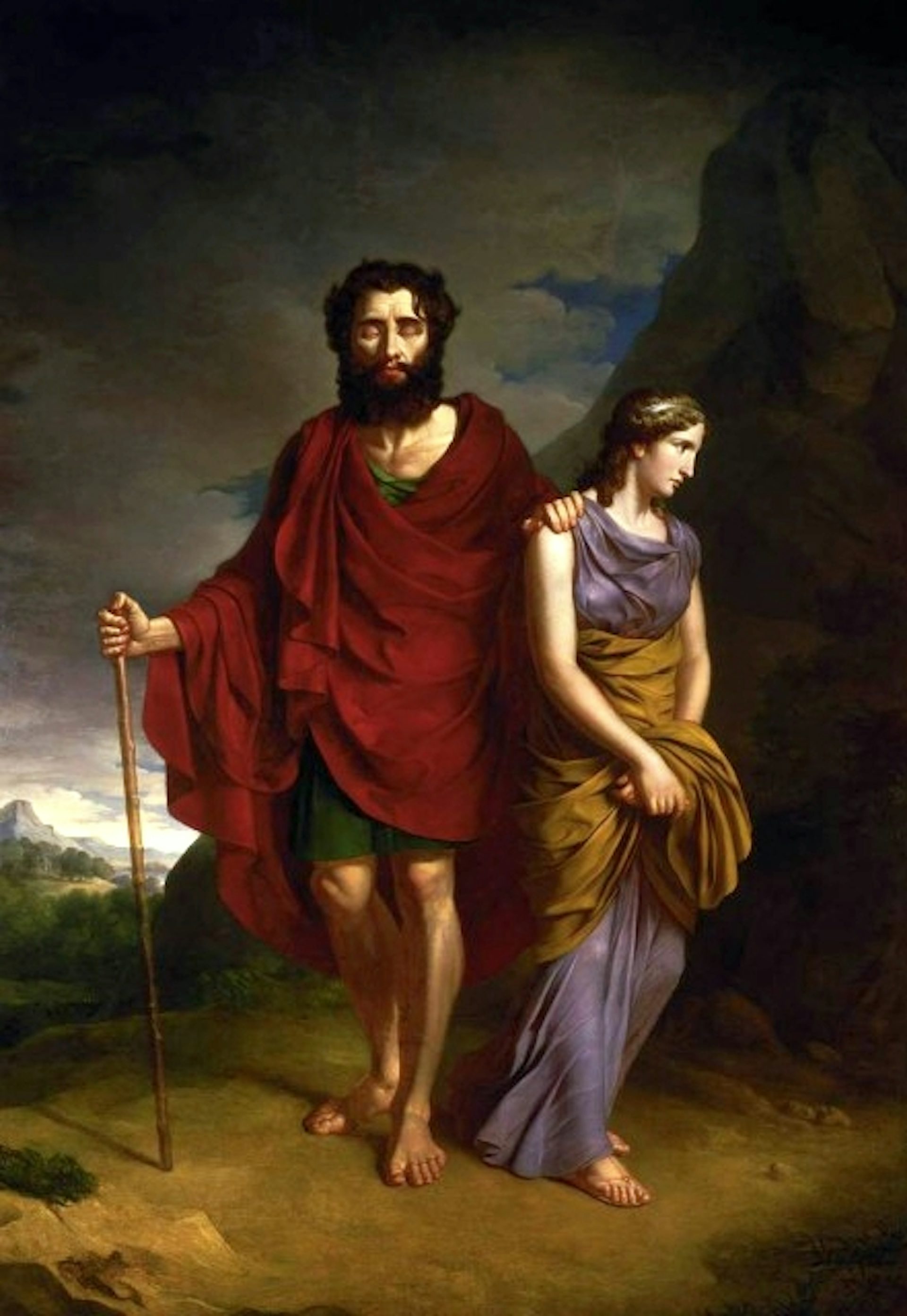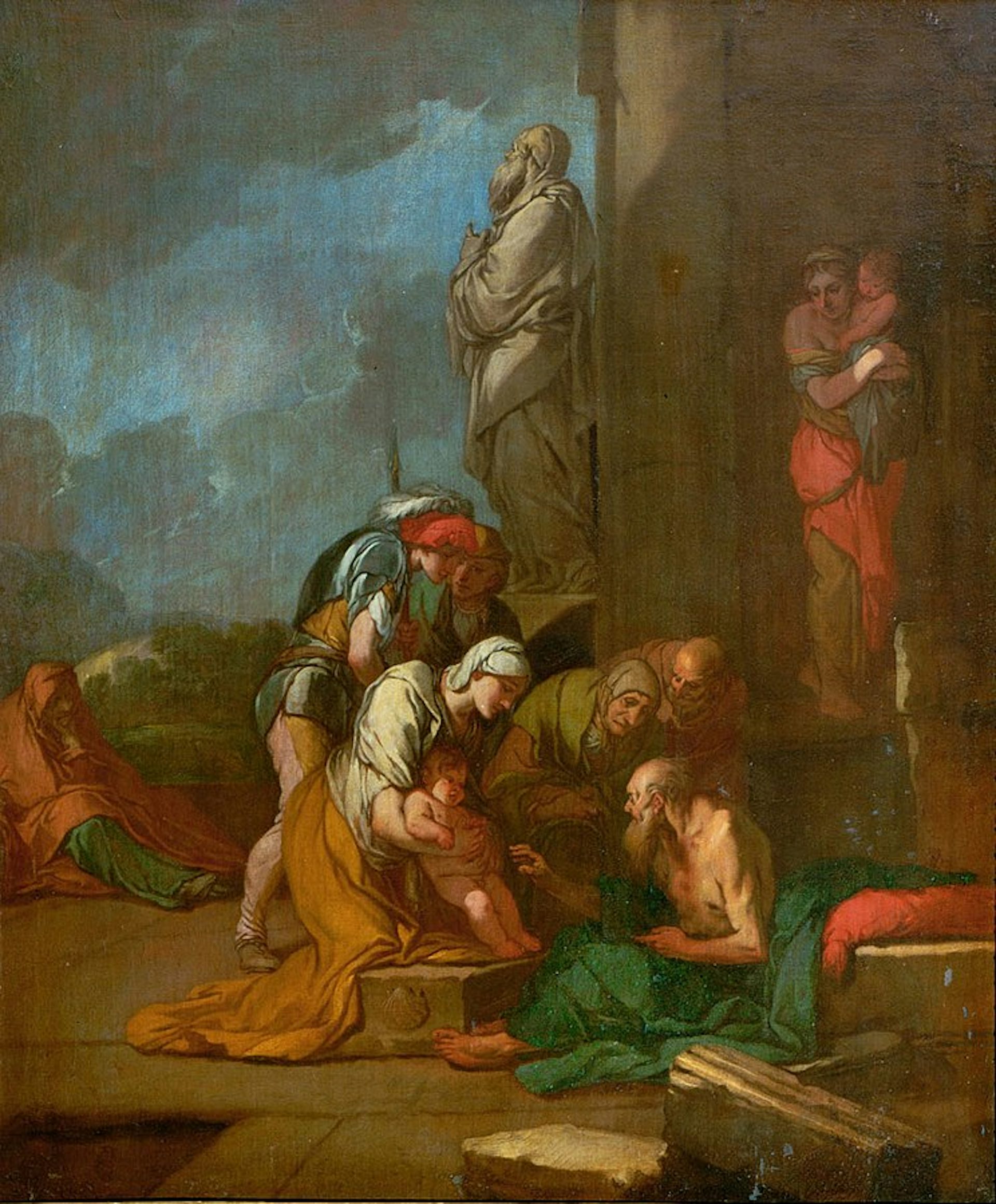Tiresias
Overview
Tiresias, son of the nymph Chariclo, was a remarkably long-lived prophet of Thebes. Inseparable from the mythology of his storied city, he played a central role in the lives of everyone from Cadmus to the Seven against Thebes.
Tiresias was blessed with experiences and abilities that went beyond his famous clairvoyance and longevity. Though born a man, he was transformed into a woman after he killed a copulating female snake; eventually, after marrying and giving birth to children, (s)he was transformed back into a man. In the end, Tiresias was struck blind by the gods—in some versions because he had offended Athena, in others because he had offended Hera.
Tiresias was an important prophet even in death. For example, the Greek hero Odysseus visited the Underworld during his decade-long journey home from the Trojan War, seeking advice from the long-dead Tiresias.
Etymology
The name “Tiresias” (Greek Τειρεσίας, translit. Teiresias), also spelled Teiresias, seems to have been derived from the Greek word teras, or its variant teirea. Though this word has several meanings—“sign,” “omen,” “wonder,” “monster”—it was broadly used to signify something divine. It is likely related to the Indo-European *kwer-, meaning “magical sign” or “omen.”[1]
Pronunciation
English
Greek
Tiresias (or Teiresias) Τειρεσίας (translit. Teiresias) Phonetic
IPA
[tahy-REE-see-uhs] /taɪˈri si əs/
Attributes and Iconography
Tiresias boasted several famous attributes—most notably, the gift of divination, which he received from the gods. He was a prolific diviner, obtaining his information about the future through prophetic visions as well as augury (the interpretation of the songs and flights of birds). According to ancient sources, he was awarded these abilities as compensation for his blindness (which also came from the gods).
Tiresias also carried a special staff, made of either cornel wood or gold (there are different versions), which he used to guide his steps.
Finally, Tiresias is remembered for his highly unusual life: he was born a man, lived for several years as a woman, then was transformed back into a man. He also lived much longer than other mortals—for as many as seven generations.
In ancient art, Tiresias was represented as a bearded prophet, often with a staff and other religious accoutrements. As far as we know, he was never depicted in his female form.[2]
Family
Tiresias’ mother was Chariclo, a nymph devoted to the goddess Athena. His father was a Theban named Everes who may have been descended from one of the Spartoi, or “sown men,” the race of warriors who sprang from the earth when Cadmus first founded Thebes and sowed the dragon’s teeth given to him by the gods.[3] This meant that Tiresias belonged to the oldest and most respected family in mythical Thebes.[4]
Family Tree
Parents
Father
Mother
- Everes
- Chariclo
Children
Daughters
- Historis
- Manto
Mythology
Origins: The Blind Prophet
There are different versions of how Tiresias became the famous blind prophet of Thebes, at least two of which were well known in antiquity.[5]
The Bath of Athena
In one myth, Tiresias happened upon Athena one day while she was bathing. When Athena realized that Tiresias had seen her naked, she immediately struck him blind.

The so-called "Athena Varvakeion," a small Roman replica of the famous statue of "Athena Parthenos" by Phidias (first half of the 3rd century CE). National Archaeological Museum in Athens, Athens, Greece.
MarsyasCC BY-SA 3.0Chariclo, Tiresias’ mother and one of Athena’s attendants, begged the goddess to restore the boy’s sight. Athena explained that she could not do so; however, she did give Tiresias several valuable gifts as compensation for his lost eyesight. Callimachus imagines Athena’s words to Chariclo in his fifth Hymn:
I will make him a seer to be sung of men hereafter, yea, more excellent than any other. He shall know the birds – which is of good omen among all the countless birds that fly and what birds are of ill-omened flight. Many oracles shall he utter to the Boeotians and many unto Cadmus, and to the mighty sons of Labdacus in later days. Also will I give him a great staff which shall guide his feet as he hath need, and I will give him a long term of life. And he only, when he dies, shall walk among the dead having understanding, honoured of the great Leader of Peoples.[6]
Thus, Tiresias’ powers of divination, magical staff, longevity, and even his ability to continue prophesying after death were all gifts from Athena. Between these, Tiresias was able to navigate life just as well as, if not better than, an ordinary sighted mortal.[7]
Snakes, Spontaneous Sex Changes, and the Wrath of Hera
The alternative myth of how Tiresias gained his powers is much stranger. This version also begins with Tiresias coming across an unusual sight in the woods: two copulating snakes. Tiresias killed the female snake (or, in some versions, both snakes); as a consequence, he was instantly transformed into a woman.
Tiresias went on to live as a woman for some time (seven or eight years in most sources). One day, however, he again happened upon two copulating snakes. According to some sources, Tiresias was able to cancel out his earlier misstep by killing the male snake; in others, he simply killed both. Either way, Tiresias was transformed back into a man.
This remarkable experience left Tiresias uniquely well placed to resolve a dispute between Zeus and Hera. The king and queen of the gods apparently could not agree on whether the male or the female derived more pleasure from sex. So they asked Tiresias—who had lived as both a man and a woman—to resolve the matter once and for all. Tiresias’ response was widely circulated in the ancient world:
Of ten parts [of sex] a man enjoys one only;
But a woman enjoys the full ten parts in her heart.[8]
Hera, apparently, found this response humiliating and punished Tiresias by striking him blind. But Zeus pitied Tiresias and compensated him by granting him the gift of divination—and, according to some sources, a life that spanned seven generations.[9]
Tiresias and the Theban Myths
As a prophet, Tiresias was an ever-present (if often reluctant) figure in the mythology of Thebes, one of the most famous and storied cities of Greek mythology.
Cadmus
Tiresias’ association with Thebes can be traced back to the very origins of the city. In several sources, Tiresias gives prophecies to Cadmus, the founder of Thebes.[10] In Euripides’ Bacchae, Tiresias joins the aged Cadmus in unsuccessfully urging Pentheus, the young king of Thebes, to acknowledge the divinity of Dionysus.[11]
Oedipus
Tiresias’ presence in Theban myths continued unabated for several generations. He was thus alive and well to advise the Labdacid kings of Thebes, named after Cadmus’ grandson Labdacus.
In one myth, for example, Tiresias was summoned to help Oedipus solve the murder of Labdacus’ son Laius, the previous king of Thebes. In literary representations of this exchange—most famously, in Sophocles’ Oedipus the King—Tiresias is initially reluctant to speak; but when Oedipus presses him, Tiresias becomes angry and insinuates that Oedipus himself unknowingly murdered Laius:
I tell you: the man whom you have been seeking this long while, uttering threats and proclaiming a search into the murder of Laius, is here, ostensibly an alien sojourner, but soon to be found a native of Thebes; nor will he enjoy his fortune. A blind man, though now he sees, a beggar, though now rich, he will make his way to a foreign land, feeling the ground before him with his staff. And he will be discovered to be at once brother and father of the children with whom he consorts; son and husband of the woman who bore him; heir to his father's bed, shedder of his father’s blood.[12]
Soon after, Oedipus realizes that not only did he kill Laius, but Laius was his father. Since he had married Laius’ wife Jocasta after the murder, Oedipus is left to conclude—to his horror—that he had killed his father and married his mother.[13]

Oedipus and Antigone by Antoni Brodowski (1828). National Museum in Warsaw, Warsaw, Poland.
Wikimedia CommonsPublic DomainThe Seven against Thebes
Years later, Oedipus’ sons Polyneices and Eteocles quarreled about which of them should rule Thebes. They eventually decided to take turns, ruling on alternate years. At the end of his year, however, Eteocles refused to turn power over to Polyneices. The enraged Polyneices assembled an army led by seven commanders, including himself, and attacked Thebes—an assault known as the war of the Seven against Thebes.
During this war, Tiresias used his prophetic abilities to give aid to the Thebans. He revealed that Thebes would only be saved if Menoeceus, the son of the Theban nobleman Creon and a descendant of Cadmus’ Spartoi, sacrificed himself. Menoeceus thus threw himself to his death from the walls of the city. Polyneices and Eteocles then tried to settle the war in single combat, but they both ended up dead. A battle broke out, and in the end the Thebans managed to kill most of the so-called Seven against Thebes and rout their army.[14]

Terracotta pediment from the Temple of Talamone in Etruria showing the fate of the Seven against Thebes (2nd century BCE). National Archaeological Museum, Florence, Italy.
TetraktysCC BY-SA 3.0After the war was over, Creon decreed that the body of the traitor Polyneices was to be left in the open, for vultures and dogs to devour. But Polyneices’ sister Antigone defied the order and buried her brother. She was caught, and as punishment for her defiance, Creon ordered that she be buried alive. Once again, Tiresias appeared at the palace: he warned Creon that if he did not revoke the order, the gods would punish him for his impiety.[15] Sure enough, Creon’s son Haemon killed himself when Antigone (to whom he was betrothed) was executed.[16]
The War of the Epigoni and the Death of Tiresias
A generation after the Seven against Thebes, the sons of the original seven commanders—collectively known as the Epigoni (literally “offspring”)—sought to avenge their fathers by conquering Thebes. This time, the Theban army was roundly defeated.
When the battle was over, Tiresias advised the Thebans on the best way to save themselves. He suggested that they send a herald to the Epigoni under the pretense of negotiating the city’s surrender. This would buy the Thebans time to make their escape.
The Thebans did as Tiresias advised. Tiresias then joined the rest of the Thebans in fleeing the city. While passing by the Spring of Tilphossa, Tiresias stopped to drink. He died then and there, having lived through the entire mythical history of Thebes, from the foundation of the city to its destruction.[17]
Other Theban Myths
As the ubiquitous prophet of Thebes, Tiresias made brief appearances in several other Theban myths.
According to Ovid’s Metamorphoses, for example, the nymph Liriope (who lived near Thebes) consulted Tiresias to learn whether her son Narcissus would have a long life. Tiresias’ response was cryptic:
If he but fail to recognize himself,
a long life he may have, beneath the sun.[18]

The Nymph Liriope Bringing her Son Narcissus to Tiresias by Giulio Carpioni (ca. 1671). Kunsthistorisches Museum, Vienna, Austria.
Wikimedia CommonsPublic DomainOnly later did Tiresias’ meaning become clear: one day, the handsome Narcissus happened to see his reflection in the water. Stunned by his good looks, he could not tear himself away and remained rooted to the spot until he died and was transformed into the Narcissus flower.
Tiresias was also sometimes said to have been present at the birth of Heracles, the great strongman, who had Theban roots. Tiresias predicted Heracles’ deeds, from his labors to his ultimate deification.[19]
Odysseus
It is unusual for a Greek mortal’s mythology to continue after their death, but Tiresias was nothing if not unusual. While Odysseus was trying to find his way back home to Ithaca after fighting in the Trojan War, the witch Circe advised him to go to the Underworld to seek instructions from Tiresias:
To him even in death Persephone has granted reason, that he alone should have understanding; but the others flit about as shadows.[20]
Odysseus followed Circe’s advice. He found Tiresias in the Underworld among the shades of the dead and asked him what he needed to do to get back home. Tiresias warned Odysseus that he and his men would soon put in at the island of Thrinacia, and that they must avoid harming the cattle of the sun god Helios while they were there.

Tiresias Appearing to Odysseus by Henry Fuseli (1780–1785). Albertina, Vienna, Austria.
Wikimedia CommonsTiresias also told Odysseus that Poseidon was angry at him for blinding his son Polyphemus, and that after returning to Ithaca he would need to set out on another journey to atone for this sin: Odysseus would travel by land with an oar on his shoulder until he reached a place where nobody knew of the sea or seafaring. He would know he had gone far enough when a passerby mistook his oar for a winnowing fan. There, he would plant the oar in the earth and sacrifice to Poseidon. Only then could he finally return home.[21]
Worship
Tiresias was honored with a few tombs or cenotaphs in the ancient Greek world. The most famous one was at Thebes, close to the Spring of Tilphossa (where Tiresias was said to have died).[22] Nearby was a sacred spot for birdwatching and augury.[23] Another of his tombs was located in Macedonia.[24]
There was also an oracle near Thebes who was connected with Tiresias. But the oracle’s prophecies ended after a terrible plague ravaged the Boeotian city of Orchomenus; it was said that the gods stopped speaking through the oracle after that.[25]
Pop Culture
Tiresias has made a number of pop culture appearances over the years, inspiring modern poets such as Alfred Tennyson, T. S. Eliot, and Ezra Pound. He was also the subject of Frederick Ashton’s ballet Tiresias, which premiered in 1951. More recently, Tiresias has featured in cinematic adaptations of Greek mythology, including the 1997 television miniseries The Odyssey.